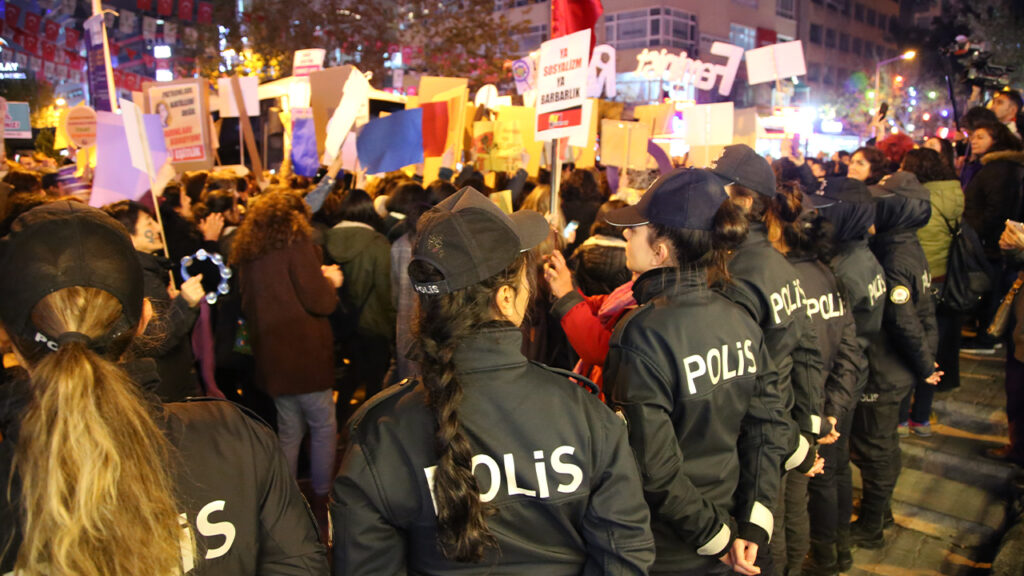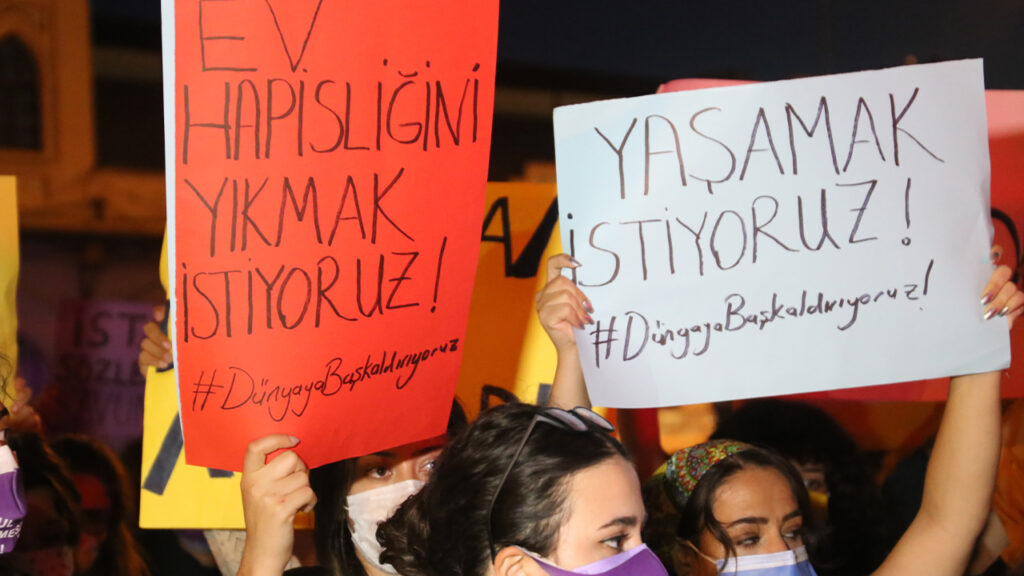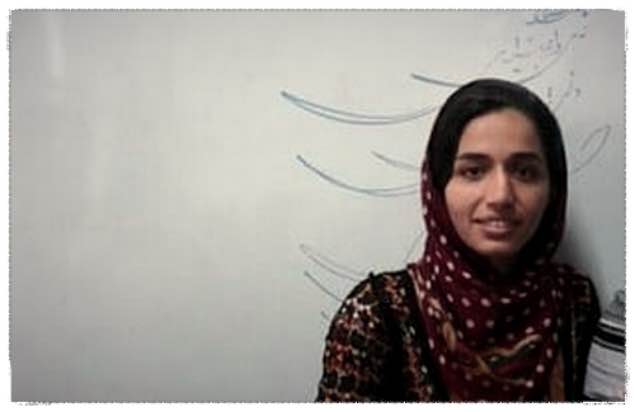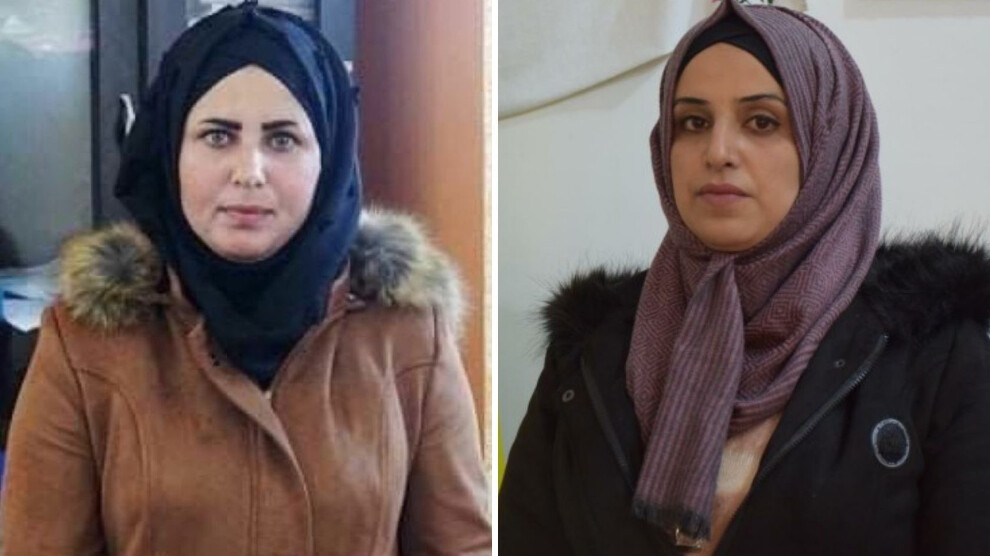Debates on femicide have intensified this century. It is happening because of the contradiction between the patriarchal system and women’s demands for freedom, which have intensified.
As women’s awareness about their rights and freedom increases, they resist more. However, attacks against women’s rights also increase at the same time. The capitalist system cannot continue to exist without the exploitation of women’s labour and their bodies. The colour of the exploitation is changing but the capitalist system continues to operate. At this point, we see that ongoing struggles are not sufficient to stop femicides. Protests against the killings of women, demanding punishment for the murderers, continue. Protesting the attacks against women’s rights are effective, but they are not capable of transforming the system. We have to go beyond reacting to these discourse or individual incidents.
Domestic violence still not considered a crime
The definition of violence against women is always changing. Whilst physical violence was more visible in the past, economic, psychological, emotional, and cultural violence have been made visible through the struggles of women. Domestic violence is still not considered a crime in all aspects.
Today, digital violence crimes are on the rise. A recent study revealed that 89% of women in Tunisia experienced digital violence. In addition to the violence, women suffered from being women. They are also subjected to violence due to their beliefs, ethnic origin, and class status. However, it was never made visible enough.
Violence is naturalized
One of the difficulties of defining violence against women and femicide stems from the naturalization of violence. It took years to accept that women being raped by their husbands or lovers was a crime. Marital rape is still not defined as a crime in many legal systems. It is considered ‘normal’ in our society to kill women under the name of ‘honour killings’ because they are seen as the property of the father, spouse or brother. Religious discourses also play an important role in the increase in violence against women.
Women being seen as ‘meta’ is also another type of violence against women. Fashion, cosmetics and pornography force women to look always beautiful and desirable. Women are also forced to think in a specific way about violence. They are forced to think that the reason that every individual woman faces violence is not systematic. Either it is due to a man who is mentally sick or has a bad moral character. The concept of femicide had an important role in revealing the truth about violence against women. It revealed that it is a policy: it is not applied by individual men towards individual women, but it is a systematic method used in a male-dominated system.
‘Four big operations’
First, we need to examine the historical background. How did men gain these rights? The Kurdish people’s leader Abdullah Öcalan writes about ‘four big operations’ in his book, ‘The sociology of freedom’:
- Firstly, we need to consider women as being slaves in the household. Women are seen as the property of the family, her owners. Women are responsible for the continuation of the bloodline.
- Secondly, we need to consider that women are seen as sex objects. Sexuality is related to procreation. Men are seen as having an active role in sex.
- Thirdly, we need to consider women’s unpaid labor. There is a belief that women are lesser than men. They are humiliated.
- Finally, we need to consider the commodification of women. They are seen as ‘meta’.
Without understanding these sociological and cultural aspects of the male-dominated system, we cannot understand femicide.
No trial for war crimes
Taking women as slaves and concubines in wars and imprisoning them in harems and raping women should also be considered within the scope of femicide. Women who belong to oppressed groups face state-based violence along with male violence. Exposing the dead bodies of women guerrillas, putting sexist curses on the walls, selling women as slaves in the markets are practices that we have recently faced as Kurdish people. Operations against women activists and revolutionarists were also different aspects of femicide. Women who are fighting for their freedom are targeted more and also murdered in more violent ways.
Hevrîn Xelef, Barîn Kobanê, Zehra Berkel were the symbols of that in Rojava. If crimes against women were to be tried in more special courts, today’s practices in Sincar and Afrin or Boko Haram in Africa could have been prevented.
It is wrong to limit the definition of femicide to only killings of women. Women are being attacked also without being physically harmed. For instance, the ban on language, the pillage of geography, economic colonialism, assimilation, etc. How many women have to make concessions for themselves for fear that the man will beat or kill her, kick her out of the house, leave her, not give her money, harm her children or rape her?
Systemic solutions are needed
We need more systemic solutions to stop femicide. To attain that goal:
- Struggle is necessary for the mental aspects of the relations. For instance, we have to target the transformation of dominance in all male and female relationships, especially love, sexuality, marriage and family. We name this “free co-life theory”.
- If masculinity is constructed in opposition to femininity, every man is grown up as a potential woman killer. It will take a long time to transform this male identity, so we need to limit this man first. We define this as the killing of masculinity based on sovereignty. You cannot be a comrade, friend, colleague or lover with a dominant man.
- Mental transformation of men has to occur. It takes a long time, full of struggle, to acheive this. For this reason, we need to make women organized, defensive, conscious, and economically self-sufficient. We need to develop institutions that will not leave women at the mercy of men and states. Organizations where women can say ‘stop’ to the murderer. We need tools, methods and institutions to defend ourselves against attacks, and communal living environments that will enable us to continue our lives. We do not see these places as shelters but rather as “free-living spaces”. Women’s cooperatives, women’s academies, women’s villages, women’s communes are the institutions that can be established for this.
- There must be political spaces where women can gain the power to speak, decide and implement things in all vital matters. We are trying to do this with equal representation in every field, in co-chair structures and in women’s assemblies. When the will of women was not recognized in war and peace negotiations, in making laws, and in the administration of cities, women had to pay very heavy prices.
- Women should have self-defense organizations, including armed ones in the battlefield, the means to defend themselves individually, the means to protect their feelings and thoughts and their psychology against the traps of capitalism and male domination. Therefore, a broad definition and institutionalization of self-defense organizations is required.
- We need to understand that domestic violence is a result of state and patriarchal system relations. Therefore it is not logical to expect states to protect women and to implement protective laws and contracts. We must ensure that the gains created by women’s organizations, actions and resistance are implemented through women’s social contracts. Although there are many laws and conventions against femicide and violence, they are not capable of preventing femicide.
Women’s organized power and resistance can be the guarantor of these conventions. As a result, we can say that femicide operates as a system with historical, cultural, political, and economic dimensions. We also need to produce systemic solution based strategies in the fight against it.
by Zozan Sima, Yeni Özgür Politika





